Exploring the Vibrant World of Modern Bohemian Interior Design
Have you ever visited a market, hustling and bustling with vendors and visitors alike, all gravitating around the wealth of items for sale? Perused the shelves upon shelves of cutlery, rifled through swatches of fabrics and picked at piles of little trinkets.
Just as a vibrant bazaar might be home to any number of beautiful things, so is a bohemian space a curated collection that showcases the interests and taste of its maker. Just so, bohemian interior design seeks to create spaces where each piece speaks louder than words.
What is Modern Bohemian Interior Design
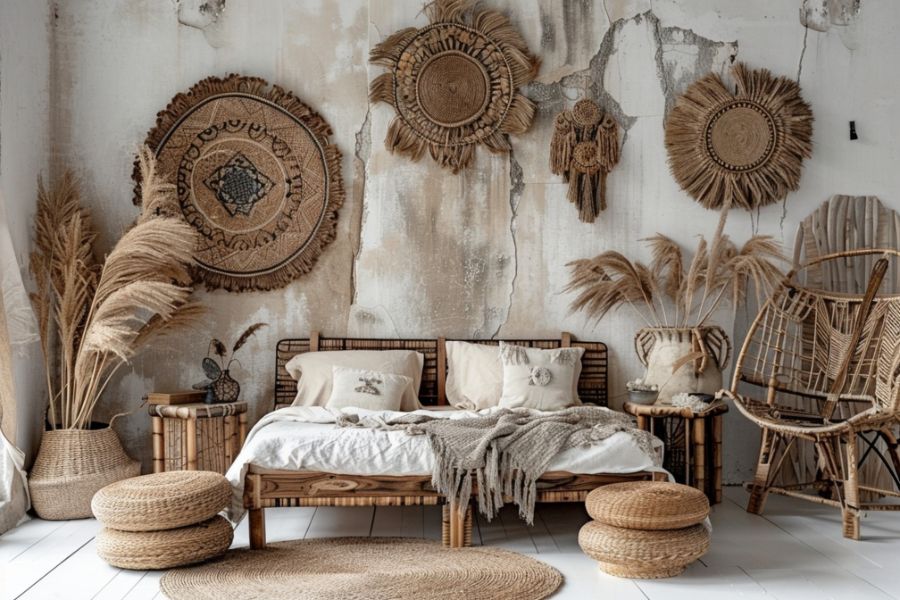
Characterised by a free-spirited look, the modern bohemian interior design trend has cropped up in any number of films and television series over the last couple of decades. It is specifically used to signal to the audience a switch to the hippie-infested 60s. But that doesn’t adhere to a specific time because bohemian styles are evergreen and have been a popular choice for homes and creative spaces ever since their inception in the early 19th century. For Bohemianism is not just about the art; it’s about embodying the spirit of creativity, freedom and self-expression. Be it kitchen or bathroom, bedroom or living room, the bohemian aesthetic does not frenzy the mind with claustrophobic precision, and it creates lots of little pockets for anyone to sink into with a good book or a cup of coffee. Imagine a kitchen made inviting by adding textured stone walls accented by wooden detailing and a collection of heritage pottery in saturated tones of red, orange and yellow. Like an afternoon under the Tuscan sun, this space would reflect warmth and an old-school homeliness. But to understand the elements of bohemian interior design better, let’s take a look at its history.
Bohemian Interior Design History
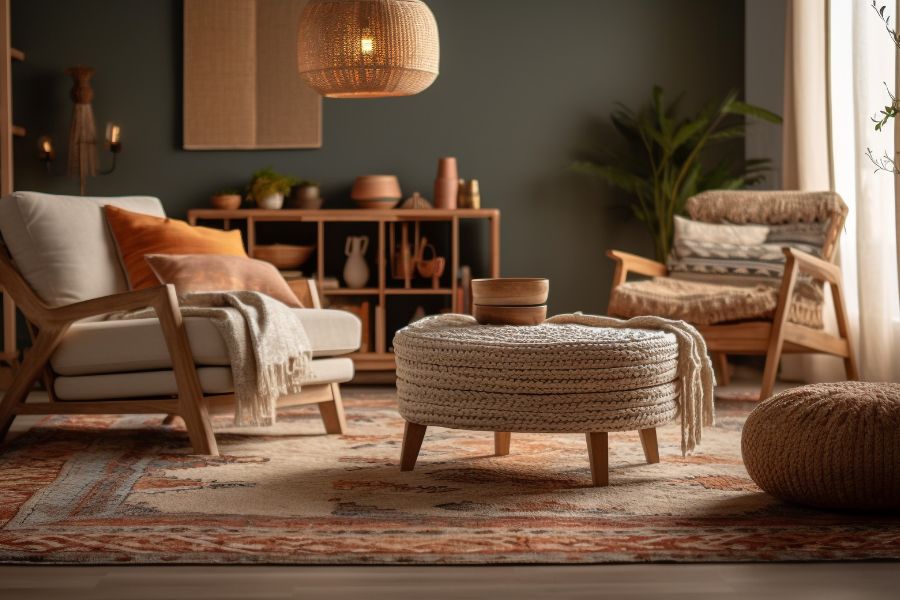
The Romani are an ethnic group of nomadic Indo-Aryans whose presence in Europe during the 19th century gave rise to the bohemian aesthetic. The French bohème was the first term used to describe this faction, as it was commonly mis-believed that they had come from Bohemia, a medieval Czech kingdom. Their travelling lifestyles, their cultural -isms, and exotic ‘other ’-ness created quite an impression on the Romantic Europeans. Their worldliness had resulted in a sense of cluttered artful chaos, a bright clashing of textures, patterns and materials that translated itself into their clothing, the decorations on their travelling caravans, and their vibrant camps. Originating at a time when, in Europe, there was a strict adherence to the structured and the conforming, the innovating eye of the West sought novelty and alternativeness. This signalled the birth of the bohemian interior design style, which took the world by storm and continues to be one of the most preferred styles for any cosy home. This is what modern bohemian interior design attempts to express, too.
Furthermore, ‘orientalism’ or the fantasy of the Global East by the Western World during the same century meant that any crafts that reflected the skill of South and East Asian artisans were highly sought after. Homes became moody reflections of the pensive temples and arching open spaces of the Orient, and eclecticism, the practice of deriving ideas or taste from a diverse range of sources, was encouraged. Just so, through the amalgamation of a traveller’s aesthetic, the bohemian aesthetic as we now know it was born: part chaos, part beauty. Its specific timber of comfortable luxury has had a universal appeal throughout history, and its best feature is that it is not environment-bound. The bohemian aesthetic can be adapted anywhere and can be borne out of a preference for various differing types of styles that come together to create a uniquely experiential space.
Bohemian Modern Interior

Compared to more modern interior design styles, the bohemian aesthetic offers a much more laid-back vibe, perfect for homes and vacation housing. The embellishments in a modern bohemian space might include statement art pieces, a variety of textures and patterns that intermingle to convey charm through personal touches. Beads, tassels, sequins and embroidery are great to play with for statement pieces, and artisanal items like cushion covers, tapestries and table runners can add a pop of colour to a milder bohemian palette. Unconventional is the word of the day, and experimental mixings of patterns with each other and with vibrant colour palettes create a jaw-dropping contrast. This is one style where you needn’t shy away from the drama; a maximalist approach helps offer variety and engagement, inciting a thought for each piece. Because it is such an artful jumble, the space seems lived in and comfortable, with a nonchalance that does not detract from the showcasing of all these wonderful artistic pieces.
Contrasting the old and the new is no mean feat, but Bohemianism leans towards a combination of binaries. Vintage furniture like hardwood coffee tables, dressing tables and bed frames offer visual weight to a room full of patterned decor. At the same time, a refurbished chandelier can add a touch of glamour to a more sober room. Genuine and free-spirited, the bohemian interior design style is easy to curate, should you know how to nail the foundational elements. Here are a few key defining characteristics that one can keep in mind.
Bohemian Style Interior Design Characteristics
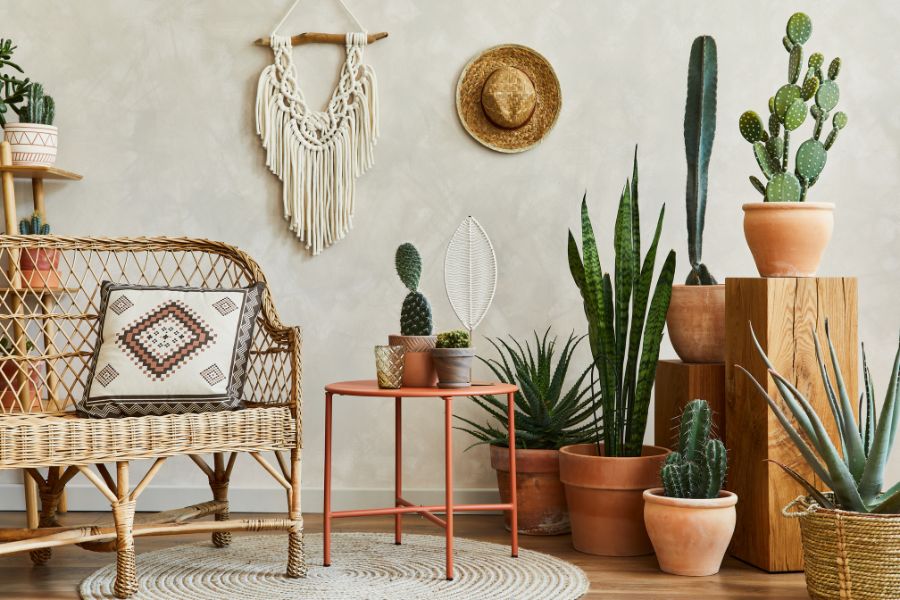
One of the key defining characteristics of the bohemian interior design style is to mimic the look and feel of natural products. Fabrics, decorative pieces and materials are simply additions to a home that can transform it from drab to eco-fab! The use of plants is one of the most well-known ways to lighten and brighten up a space, and the naturalistic leanings of the bohemian interior design aesthetic are well-suited to match! Surrounding this clean green palette with distressed-finish fabrics can add visual complexity, and materials like jute, burlap, khadi, silk and satin can add a more rustic vibe.
A bohemian home reflects the freedom of the bohemian movement and so is carefree, loose and unruly while maintaining the saturated colourfulness of its Orientalist roots. For example, lime-washed walls add texture and a rustic look to an otherwise polished room and can offer a lovely contrast to the use of velvety fabrics for furniture like a tufted chaise lounge.
Mixing and layering is something you must stand by, as it can make or break the overall style of the room. Printed wallpaper, for example, can be an innovative way to bring some life to the room and can be combined with various spots of ambient yellow-based lighting to set the tone.
Bohemian Interior Design Elements

Earth tones like umber and sienna are natural choices for a bohemian statement wall, which creates a grounded and cosy interior. One might play around with placement, clustering items and furniture together to leave open spaces that allow for natural segregation in larger rooms. One might even make use of wooden dividers and room screens to make the distance more tangible, and a traditional Chinese or Indian-crafted screen can emphasise the worldliness of the collection.
Macrame, jute, wicker, and textured fabrics are your best friend. You can create visual depth by adding various rugs and textured wall tapestries, and replacing square boxes with baskets made of wicker or jute can be a simple substitute that can add to the cosiness of a space. Rugs are a must, they add visual weight to a room and can be used to delegate separate inner spaces in a room. They’re also incredibly tactile, which can help make a room more immersive and sensorily engaging.
The bohemian interior design aesthetic also encourages the showcasing of art, so having trinkets, souvenirs from your travels, and art pieces like paintings and sculptures around the space will help add character to a room. In essence, a bohemian home functions as a conversation starter. Every piece in the space has been curated and holds its heritage at par with others in a global showcase. This unique collection of items can also include things that are heirlooms or handcrafted, adding even more historical relevance to their worth. Eclecticism is key!
Bohemian furniture might be categorised by its inclination to lounge, and many pieces that make up the style canon may be along the lines of chaise lounges, daybeds, plush sofas and thick ottomans.
Bohemian Traditional Decor
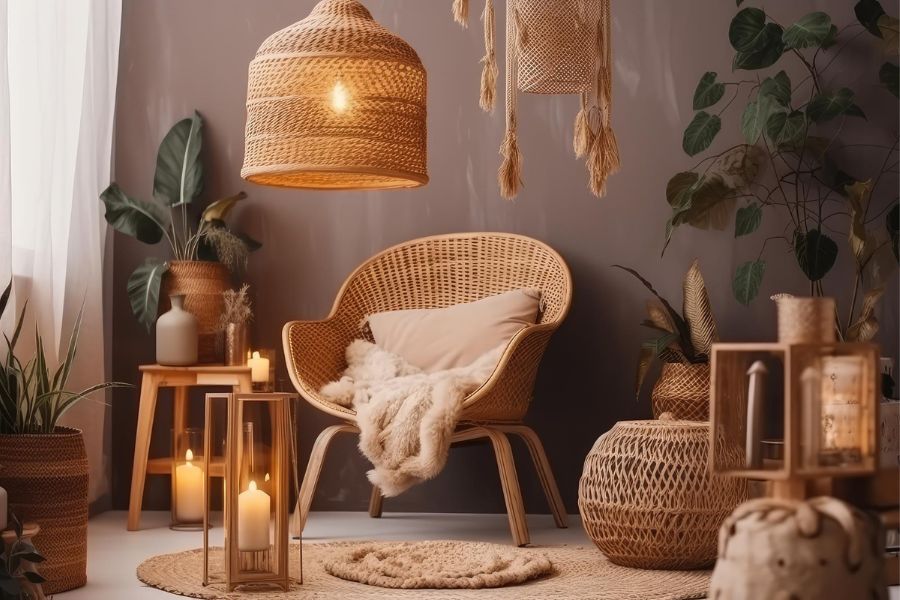
The historical inspirations of the bohemian style range from the gilded walls of English countryside estates to the smokier facades of some of France’s most visited nightclubs. Just as the bohemian interior design style is popular now, it shares these interests in the boho with eras through time.
More traditional bohemian interior design colour palettes include earth tones like beige, khaki, dark greens and reds while attempting to replicate the natural world inside the walls of one’s home. A more modern approach might make use of bright colours, such as the Marrakech-inspired white-and-blue palette or contemporary Indian designs.
Two poles might define a traditional bohemian space; either the walls are painted in darker tones or a colour that leans towards a more neutral colour palette. Walls of deeper gem tones such as ruby, emerald and satin teal are luxurious touches to a bohemian interior design room. They are easily contrasted with furniture that amplifies the curiosity of the observer. Little bits and bobs, statement pieces and souvenirs litter the space, with the potential to start an exciting conversation. Eclecticism in shape can be complementary to bohemian interior design, with lamps, shades, rugs, and coffee tables being thrown together in various fascinating combinations.
The lighter-toned option for a bohemian room leans towards neutral beiges and whites, with contrasts offered by wooden pieces and brightly coloured fabrics, if at all.
Since the inspiration for the style came from the bohemian lifestyle and was first practised by the well-travelled Europeans, there was traditionally an incredible focus put on the regional artisanal creations that homeowners could source out on their travels. These were global pieces, representative of a specific state, a specific ethnic skill that was a testament to the culture of the land. Japanese shibori and Gujarati ikat are examples of heirloom fabrics that can easily fit into one’s home.
What are the Different Types of Interior Design
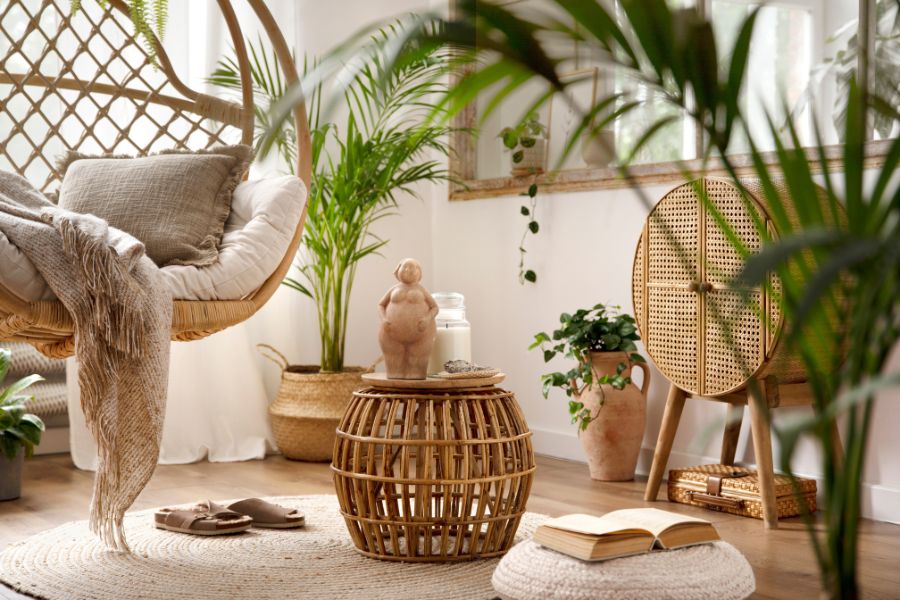
Most bohemian interior design styles are distinguishable amongst themselves by the amount of embellishment that they encourage. One of the more minimalistic styles might preach using the least amount of decor and furniture in one’s home to create a statement that amplifies the emptiness of the space. Meanwhile, a maximalist style might encourage you to stack books upon books and hammer frames upon frames into your walls to fill one’s gaze. Ultimately, the choice of which style to incorporate is dependent on the preferences and the palette of the individual.
The environment also influences some interior design styles, so you might find a bohemian aesthetic in America to mirror the incredible desert landscapes, with the use of dry tumbleweeds and cacti in decor. At the same time, a South Indian-inspired bohemia might feature coconut-shell decor and palm plants.
How Much to Budget for Interior Design
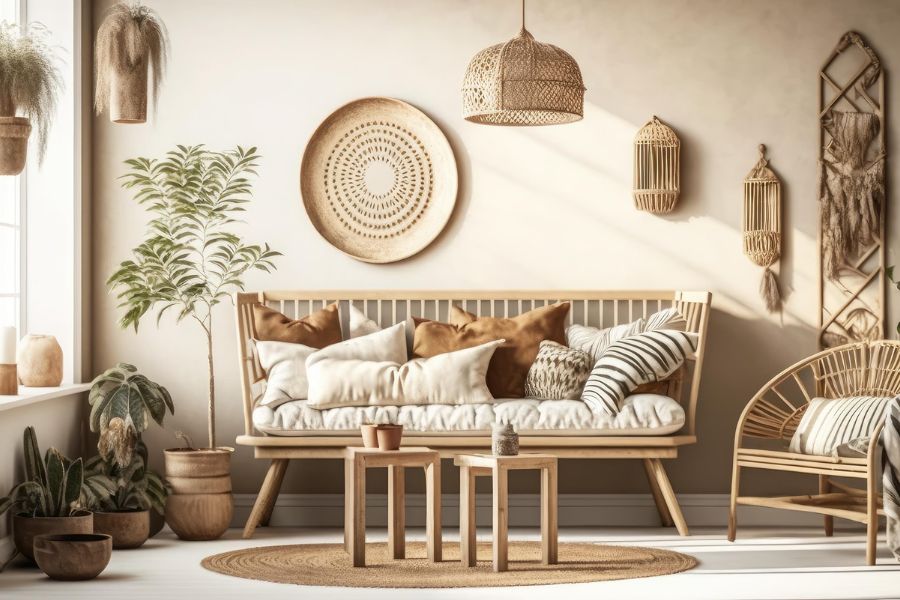
Handcrafted goods are a fool-proof way to express your interests and create centrepieces in your space that can tell a story. They can create a narrative for your home and lay bare your life in the metaphorical pages of your home. The touch of an artisan can always be discerned in work of quality, and the support that investing in these pieces shall provide to local artisans and small entrepreneurs should gratify any qualms you might have about the price.
One should also keep sustainability in mind, and so try to refurbish and bring new life to older pieces in your collection. For a thrifty buyer, second-hand furniture is an easy fixer-upper that also comes with its own stories. Yet above all is to be able to curate a cohesive home that is a welcoming and relaxing space. Whether that means splurging on the sofa of your dreams or investing in a vintage dressing table, can only be a decision for the individual to take.
Case Studies Interior Design
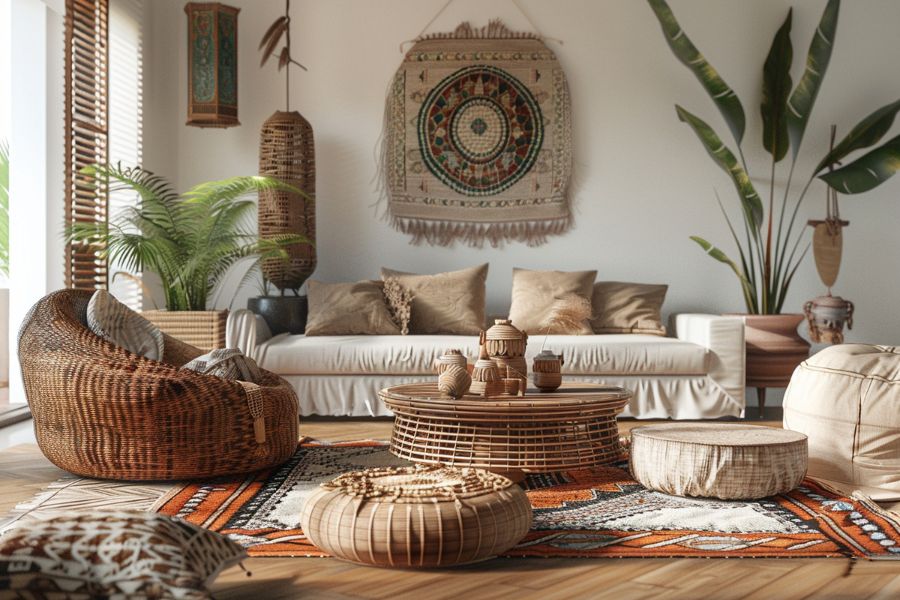
Bohemian interior design is best suited for homes. It takes very well to the individual manipulations of every person’s tastes and interests. Through the variety of the owner’s collection, the ambience of a bohemian facade is genuinely enhanced. Homeowners can play with the use of different textures and materials to their heart’s desire, and the more eclectic the choices, the more individualistic the space. Bohemian styles also create contemplative spaces through the use of furniture and decorative placement, which is well-disposed to those who practice mindfulness and seek creativity in their homes.
The bohemian style is easily adaptable to office and commercial spaces, offering a welcoming, comfortable and clean space to boost productivity. Co-working spaces can make use of little segregated nooks where employees might settle in for a long stretch of work or take a quick call. Office spaces might lean more towards the neutral colour palette of the bohemian style so as not to clutter a shared space.
Bohemian interior design elements in community spaces can be great, too, offering a more natural and lived-in look whose constant maintenance due to a high volume of visitors can often lead to it feeling clinical and sanitised. Communal spaces like community centres and recreational clubs can gravitate towards a bohemian interior design aesthetic to imply an atmosphere of open-mindedness and creative encouragement to their visitors.
Lasting Impressions
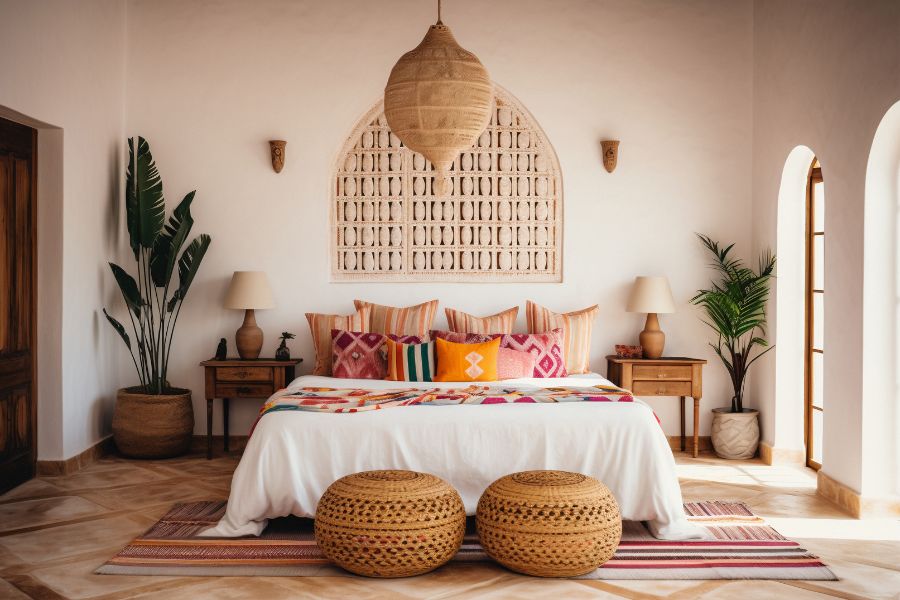
At Studio A, located in the bustling city of Mumbai, we believe that Bohemian Interior Design goes beyond mere decoration; it’s a tribute to individuality, creativity, and freedom. Our designs feature an eclectic blend of patterns, textures, and colors, crafting spaces that exude warmth, hospitality, and a distinct reflection of our clients’ personalities. Drawing inspiration from diverse cultures and historical epochs, Bohemian Interior Design at Studio A embodies a timeless allure that never fails to captivate both homeowners and designers. Whether it’s a residential, commercial, or communal setting, our Bohemian designs foster an ambiance of openness, innovation, and comfort, offering clients an unparalleled experience in crafting spaces that are as unique and vibrant as they are.
FAQs: Frequently Asked Questions
1. What is modern bohemian interior design?
Modern bohemian interior design is characterized by a free-spirited look, incorporating elements from various cultures and eras. It seeks to create spaces where each piece showcases individuality and creativity, often featuring vibrant colors, eclectic patterns, and natural materials.
2. What is the history behind bohemian interior design?
The bohemian aesthetic originated from the Romani, a nomadic Indo-Aryan ethnic group in Europe during the 19th century. Their eclectic lifestyle and cultural influences led to a style characterized by cluttered yet artful chaos, combining various textures, patterns, and materials. This style gained popularity as a rejection of the structured norms of European society at the time.
3. What are the key characteristics of bohemian interior design?
Bohemian interior design emphasizes natural products, vibrant colors, and a mix of patterns and textures. It encourages a laid-back, carefree atmosphere with an eclectic mix of furniture and decor. Plants, distressed finishes, and artisanal items are often used to add warmth and character to the space.
4. What elements are essential in bohemian interior design?
Key elements of bohemian interior design include earthy tones, macramé, jute, wicker, textured fabrics, and a variety of art pieces and souvenirs. Furniture tends to be lounge-oriented, featuring chaise lounges, daybeds, and plush sofas. Mixing and layering of patterns and textures are also fundamental to this style.
Image Reference: Freepik
Disclaimer: All trademarks, logos, and brand names are the property of their respective owners. All company, product, and service names used in this website are for identification purposes only. Use of these names, trademarks, and brands does not imply endorsement.

